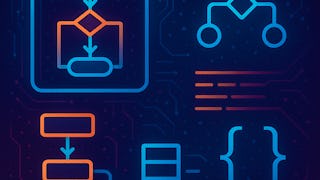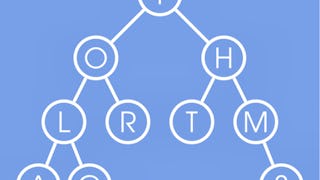How does Google Maps plan the best route for getting around town given current traffic conditions? How does an internet router forward packets of network traffic to minimize delay? How does an aid group allocate resources to its affiliated local partners?

Enjoy unlimited growth with a year of Coursera Plus for $199 (regularly $399). Save now.

Advanced Data Structures in Java
This course is part of Object Oriented Java Programming: Data Structures and Beyond Specialization



Instructors: Leo Porter
82,042 already enrolled
Included with
(1,241 reviews)
Skills you'll gain
Details to know

Add to your LinkedIn profile
See how employees at top companies are mastering in-demand skills

Build your subject-matter expertise
- Learn new concepts from industry experts
- Gain a foundational understanding of a subject or tool
- Develop job-relevant skills with hands-on projects
- Earn a shareable career certificate

There are 6 modules in this course
Welcome to the first week in the third course of our Intermediate Java Programming Specialization. Once again start with introductions, and in particular introduce the unique structure of this course. Also, if you're not sure if this course is right for you, we've got an optional pre-course quiz coming right up that can help you figure out if you're in the right place. If you decide to stay with us (and we really hope you will!) we've got a great backbone project for you: your very own mapping application, inspired by Google Maps! The core data structure throughout this course is graphs, which may very well be the most fundamental data structure in all of computer science. Ready to begin? So are we!
What's included
4 videos10 readings3 assignments1 discussion prompt
This week we'll start getting technical, introducing you to the central data structure in the course: Graphs. You'll learn the basics and then have a chance to dive in a little deeper into the code, getting ready to start building that Google Maps-like application.
What's included
17 videos7 readings3 assignments1 programming assignment
This week you'll get the backbone of your map search engine up and running. In previous courses, including the previous courses in this specialization, you've probably been given most of the classes you needed to complete the assignments. But learning how to design classes from scratch is a key skill that you will need as you become a more sophisticated Java programmer. This week we'll give you the tools you need to create a robust and elegant class design for your map search engine. We'll introduce a similar problem and show you how it can be represented as a graph. Then we'll introduce two core search algorithms: depth-first search and breadth-first search. Finally, we'll turn our graph problem into a set of Java classes. Your task on the programming assignment this week will be to do the same thing, but in the context on the map search engine!
What's included
20 videos3 readings2 assignments1 programming assignment1 peer review
In the past two weeks, you've developed a strong understanding of how to design classes to represent a graph and how to use a graph to represent a map. In this week, you'll add a key feature of map data to our graph representation -- distances -- by adding weights to your edges to produce a "weighted graph". Although this might seem like a small change, the algorithms that work for unweighted graphs may prove ineffective for weighted graphs. To address this problem, you'll explore more advanced shortest path algorithms. First, you'll see how to find the shortest path on a weighted graph, then you'll see how to find it more quickly. In the project, you'll apply these ideas to create the core of any good mapping application: finding the shortest route from one location to another.
What's included
10 videos4 readings1 assignment1 programming assignment
In this week, we'll go beyond the problem of finding a path between two points, and focus on problems requiring overall path planning. For example, if you wanted to go on errands and visit 6 different locations before returning home, what is the optimal route? This problem is actually a really well known problem in computer science known as the Travelling Salesperson Problem (TSP). Attempting to solve the problem will lead us to explore complexity theory, what it means to be NP-Hard, and how to solve "hard" problems using heuristics and approximation algorithms. We'll end the week by showing how reformulating a problem can have a huge impact: making something which was effectively unsolvable before, now solvable!
What's included
11 videos3 readings1 assignment
You made it to the last week of our course! We're glad you're still with us. As a reward, there's no new content to learn this week. Instead you'll get the opportunity to extend your project in a direction of your own choosing. We hope you've got some neat ideas for personalizing your map application, and we look forward to seeing them in the peer review gallery. Submitting to the peer review gallery is optional (though the extension is required), but we hope you'll choose to participate.
What's included
1 video2 readings1 assignment1 peer review
Earn a career certificate
Add this credential to your LinkedIn profile, resume, or CV. Share it on social media and in your performance review.
Instructors



Offered by
Explore more from Algorithms
 Status: Preview
Status: PreviewBirla Institute of Technology & Science, Pilani
 Status: Free Trial
Status: Free Trial Status: Free Trial
Status: Free TrialUniversity of California San Diego
 Status: Free Trial
Status: Free TrialUniversity of California San Diego
Why people choose Coursera for their career




Learner reviews
1,241 reviews
- 5 stars
80.90%
- 4 stars
15.47%
- 3 stars
2.49%
- 2 stars
0.72%
- 1 star
0.40%
Showing 3 of 1241
Reviewed on Aug 21, 2019
Very good course on graphs with some challenging projects. These really helped me nail down the concepts and get a deeper understanding of algorithms and data structures.
Reviewed on Apr 13, 2019
As I keep completing the assignment, I got more confident on my Java and debugging skills. I would recommend solidifying your undestanding of the Data Structures
Reviewed on Jun 3, 2017
Pretty challenging but very interesting with a lot of useful assignments. Certainly good for those who aren't familiar with a data structure called graphs.

Open new doors with Coursera Plus
Unlimited access to 10,000+ world-class courses, hands-on projects, and job-ready certificate programs - all included in your subscription
Advance your career with an online degree
Earn a degree from world-class universities - 100% online
Join over 3,400 global companies that choose Coursera for Business
Upskill your employees to excel in the digital economy
Frequently asked questions
To access the course materials, assignments and to earn a Certificate, you will need to purchase the Certificate experience when you enroll in a course. You can try a Free Trial instead, or apply for Financial Aid. The course may offer 'Full Course, No Certificate' instead. This option lets you see all course materials, submit required assessments, and get a final grade. This also means that you will not be able to purchase a Certificate experience.
When you enroll in the course, you get access to all of the courses in the Specialization, and you earn a certificate when you complete the work. Your electronic Certificate will be added to your Accomplishments page - from there, you can print your Certificate or add it to your LinkedIn profile.
Yes. In select learning programs, you can apply for financial aid or a scholarship if you can’t afford the enrollment fee. If fin aid or scholarship is available for your learning program selection, you’ll find a link to apply on the description page.
More questions
Financial aid available,
¹ Some assignments in this course are AI-graded. For these assignments, your data will be used in accordance with Coursera's Privacy Notice.

